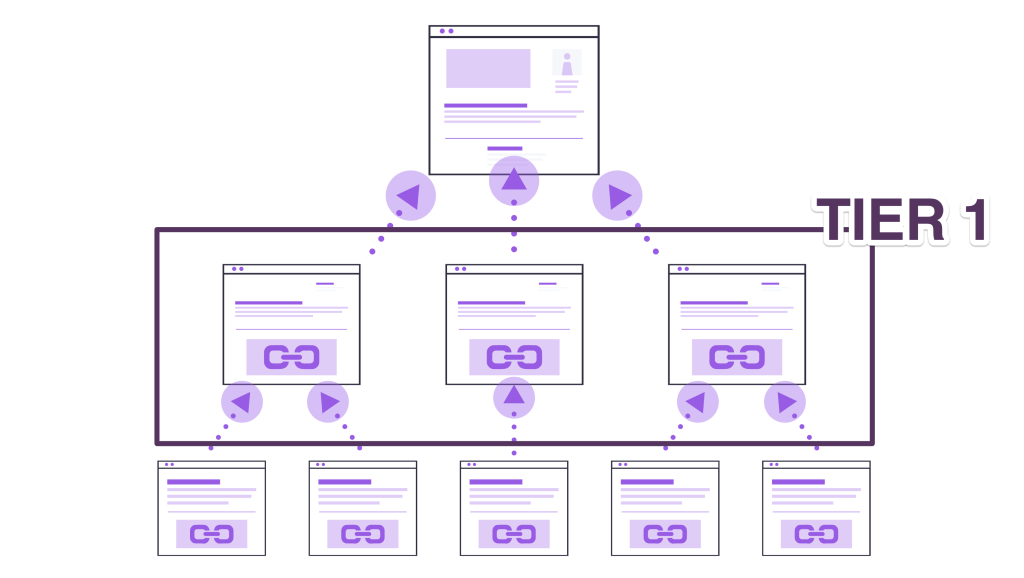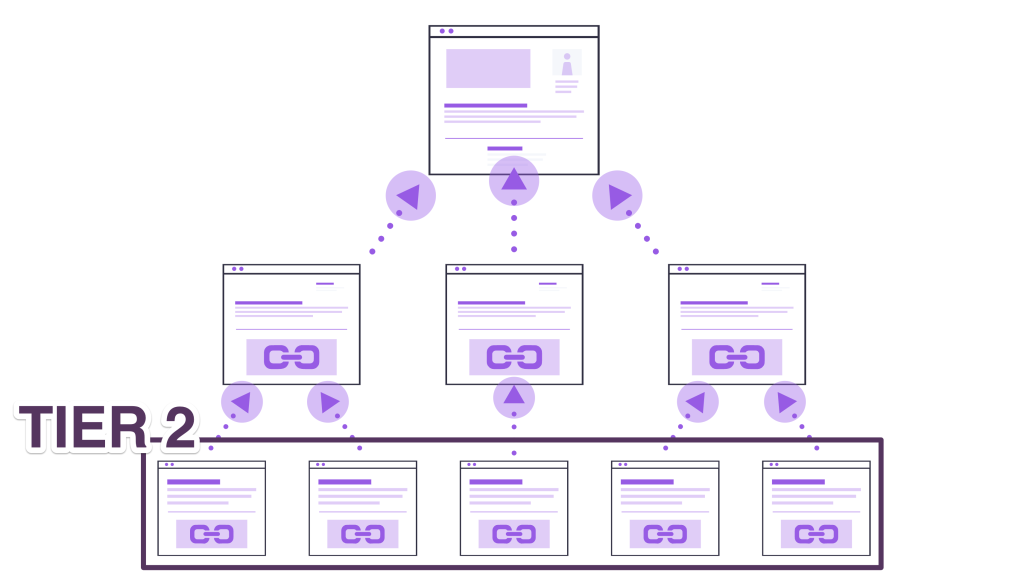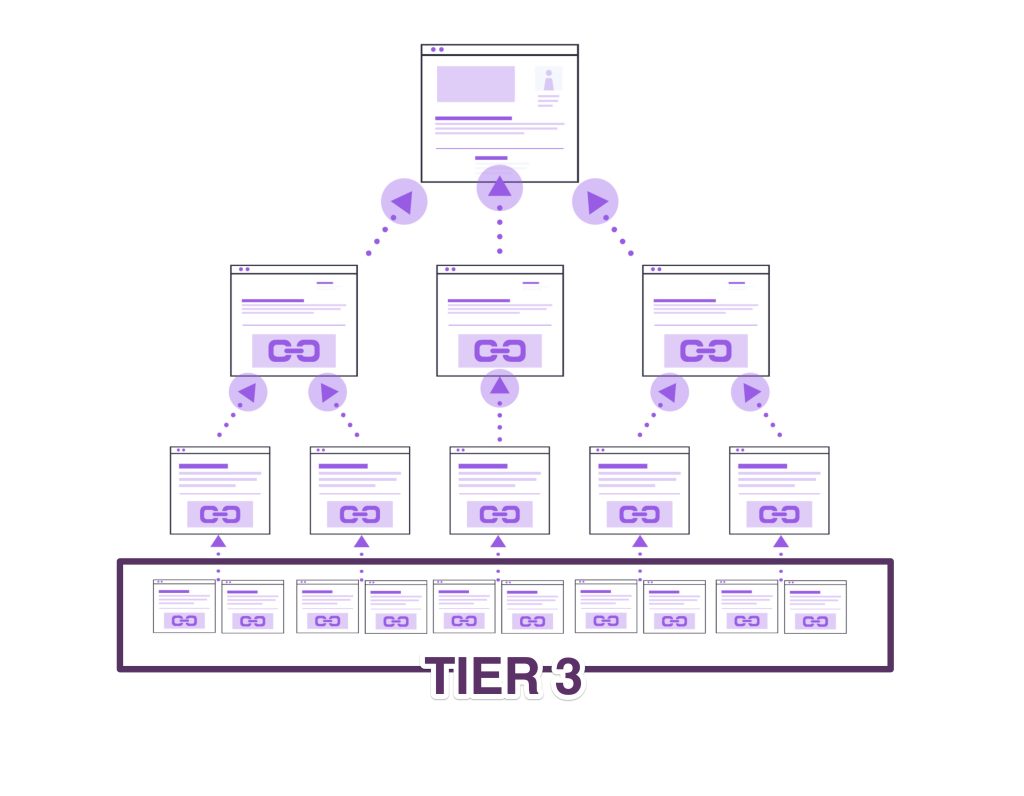What is Tiered Link Building?
Tiered link building is a technique that helps you maximize the value of your backlinks.
Essentially, it involves creating backlinks for your backlinks, ensuring that the “link juice” is passed on to the pages on your website where it will have the greatest impact on your SEO.
In other words, tiered link building allows you to manipulate the power of your backlinks and direct it towards the pages on your domain where you need them.
By creating backlinks for your backlinks, you can safely enhance your link building efforts and see better results in terms of your website’s ranking and authority.
At the end of this simple guide to tiered link building, you’ll have a solid understanding of how to effectively implement this strategy and ultimately boost your site’s SEO efforts.
Let’s jump right in.
What is tiered link building and how does it work?
If you’re familiar with SEO strategy, you know that backlinks are the most important factor in determining the authority and Google ranking of a website.
However, not all backlinks are created equal.
Some are extremely valuable, while others are… Well, let’s just say less so.
The technique of tiered link building involves creating a network of links to your website through multiple tiers or layers, with the goal of boosting the power and effectiveness of your backlinks.
Tiered link building involves creating a hierarchy of links, with each tier passing link juice onto the next.
Here’s how it works:
- Tier 1 Links: Point a backlink directly to your primary page.
- Tier 2 Links: Now point a few backlinks to the tier 1 backlink.
- Tier 3 Links: Finally point a few more backlinks to each of your tier 2 backlinks.
By building out this link hierarchy, you can amplify the power of your backlinks, ultimately directing the link juice to the pages on your website that will benefit the most.
As you can see, structuring your links in this manner offers your domain a natural link profile.
It’s important to focus on relevance at each tier. Search engines now prioritize topical relevance, so make sure that all links, especially Tier 1 and Tier 2, come from related niches. This relevance helps build a strong, contextual link profile, enhancing your site’s authority more effectively.
But with an element of grey hat strategy, it’s worth prefacing this guide with the fact that tiered link building certainly doesn’t come without risk.
Especially if implemented poorly.
When building tiered backlinks for your website, it’s imperative you and your team know what they’re doing. Otherwise, it’s worth investing in a professional.
What are the benefits of tiered link building?
Now that we have an understanding of what tiered link building is and how it works, let’s jump into the strategy’s biggest benefits.
Benefit: Low cost link building strategy
There are a number of reasons why tiered link building can be a low-cost strategy:
- Efficiency: By creating multiple tiers of backlinks, you can amplify the impact of each individual link. This means that you get more value out of each backlink you acquire, potentially reducing the overall cost of your link building efforts.
- Control: With tiered link building, you have more control over the types of links you acquire and the pace at which you acquire them. This allows greater flexibility when budgeting your link building efforts and avoids overspending.
- Magnification: High-quality backlinks can be expensive and time-consuming to obtain. By creating lower quality backlinks to your original backlinks however, you can magnify the effect of your high-quality links at a fraction of the cost.
It’s also wise to use automation for Tier 3 link creation, as this can help reduce costs and save time. Tools like GSA Search Engine Ranker can assist in generating large-scale links, though these should be carefully monitored to avoid spam.
By carefully controlling the types of links you acquire and the pace at which you acquire them, you can keep your link building costs low and maximize your SEO marketing return on investment.
Benefit: Reduces your risk of creating an unnatural link profile
Using a tiered link building strategy can help reduce the risk of your website’s link profile in a few ways:
- Diversification: By building a diverse set of backlinks to and from multiple sources, you can reduce the risk of your link profile being overly reliant on any single source. This can make your link profile look more natural to Google and avoid potential penalties.
- Quality control: For this strategy to be most effective, you must pay extra attention to your tier 1 links. We’d encourage you to still verify your lower tier links, but you can give your website some leeway.
- Link velocity: Tiered link building allows you to better control the pace at which you acquire backlinks. By not sending all your links to your select pages, you can avoid the risk of acquiring too many links too quickly.
In 2024, focus on maintaining a consistent link-building pace. Use link velocity checks in Ahrefs or SEMrush to ensure the acquisition rate looks natural, avoiding red flags that rapid or fluctuating link spikes can raise.
By carefully controlling the quality and diversity of your backlinks and the pace at which you acquire them, you can reduce the risk of your link profile being penalized by Google.
What are the risks of tiered link building?
If you’re going to jump into tiered link building yourself, it’s imperative that you also understand the risks.
Risk: You may still be penalized by Google
Here are a couple of ways that if you’re not careful, tiered link building can still get you into trouble with Google:
- Spammy links: If you use tiered link building to acquire spammy or low-quality lower tier links, you still risk getting penalized by Google. It’s not 2005 anymore and as such, it’s important to ensure that all of the links you acquire, at every tier, are of a high-standard.
- Link velocity: While this strategy affords you greater control, acquiring too many links too quickly can still raise red flags with Google. If you use tiered link building to acquire links at an unnatural pace, you continue to run the risk of getting penalized.
To prevent this, conduct regular link audits to weed out harmful or low-quality links that could jeopardize your strategy. Keeping an eye on link health is key to mitigating risk.
By still following best practices and building a natural, diverse backlink profile, you can avoid getting penalized by Google.
Risk: May get messy and hard to maintain over the long term
Here are a few reasons why tiered link building can get messy and hard to maintain over the long term:
- Complexity: Building a network of links through multiple tiers can be complex and time-consuming to maintain, especially as the number of tiers grows. It can be difficult to keep track of which tier your different links point to and ensure that they continue to provide value.
- Link quality and variety: As you add more tiers, don’t fall into the trap of thinking you can send spammy links to lower tiers. Documentation is key to keeping track of your links and allows you to maintain them over time as you start to see results.
It’s important to carefully plan, execute and document your tiered link building strategy to ensure that you’re able to track its effectiveness.
How to build a backlink profile of tiered links
Taking in all of the knowledge you’ve so far gained from this guide to tiered link building, it’s time to put what you’ve learnt into practice.
Follow this simple 3 step method to build a simple profile of tiered links for your website.
Step 1: Build your Tier 1 links
Tier 1 links are the backlinks that point directly to your website.

They are the foundation of your link building efforts and should be the ones you put the most amount of time, effort and money into acquiring.
To be effective, tier 1 links should be editorially placed within unique content and meet other criteria for backlink quality, such as coming from a reputable source and being relevant to your website’s content.
When compared to the other tiers, it’s important to ensure that these tier 1 links are of the highest quality.
As they point directly to your domain, they will have the greatest impact on your website’s ranking and authority.
Step 2: Add your Tier 2 links
Tier 2 links are the backlinks that you point to the tier 1 links that you’ve just acquired.

As they’re not going directly to your domain, the requirements for these links are a bit more relaxed than for tier 1 links.
In saying that however, it’s still extremely important to maintain best link building practices and avoid spammy or low-quality links.
Google is not stupid and you shouldn’t play with fire unnecessarily.
It’s a good idea to create a few tier 2 links for each tier 1 link and to maintain diversity in terms of sources, contexts, and anchor texts.
It’s also a good idea to place tier 2 links within your other guest posts on high-authority websites, if possible.
By adhering to these rules, you can ensure that your tier 2 links will be effective and contribute to amplifying the impact of your tier 1 links.
Step 3: Add your final Tier 3 links
Tier 3 links are backlinks that point to your second-tier links.

So that means that you’re another level removed from your own domain.
At this level, it’s okay to cautiously generate backlinks at scale, but we’re not going to tell you to compromise on quality if you don’t have to.
It’s a good idea to avoid jeopardising your main website or your first-tier link partners by only pointing your third-tier links at second-tier links.
Just keep in mind that the number of third-tier links you create has to be immense.
This is because the chance of links coming from these lowest quality, easy to acquire sources won’t be indexed or even permanently remain.
Additionally, the amount of authority passed from third-tier links to your website is minimal, so you’ll need to create thousands of third-tier backlinks to receive any tangible results.
Despite these challenges, third-tier links can still be a useful way to amplify the impact of your higher-tier links.
Just be sure to follow best practices and remain cautious about the quality of the links you use.
Final thoughts: Does tiered link building really work?
Yes, tiered link building really works.
To maximize the effectiveness of this strategy in 2024, continuously monitor link relevance and quality, using tools to track progress. With algorithms evolving rapidly, an adaptable, monitored approach to tiered link building ensures long-term success.
If you’re still in doubt or would just like to speak to one of our team of experienced link building specialists about tiered link building, then get in touch with us today.